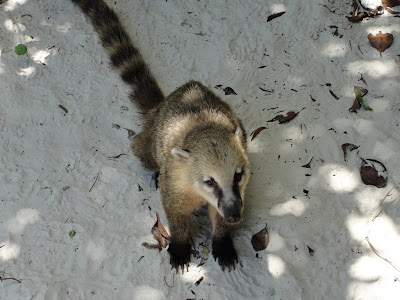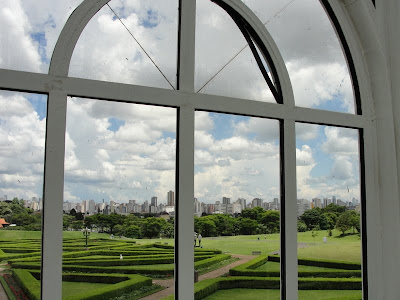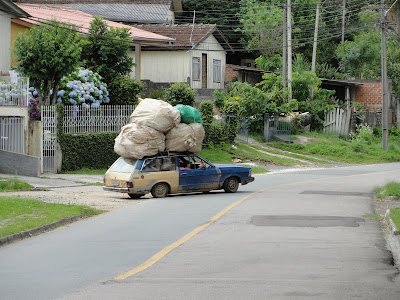Inside a moving bus that was crossing the Iguazu River Bridge, we stood supporting ourselves by firmly holding the metal handrails. Our large backpacks, between our knees, bounced and jolted in effort to escape to the lowest possible ground. I bent my head down to improve my view of the world passing outside the window. I looked just in time to see the painted concrete barriers of the bridge change from rapidly repeating colors of light blue and white to green, blue and bright yellow. The flags had changed. “I’m glad we’re here,” I thought to myself as a bearded smile broke.
Without a word or gesture to preface the language barrier, we shamelessly and presumptuously spoke Spanish to these new Brazilian faces. It worked though. They understood our Spanish, answered in Portuguese and without much trouble we were able to communicate. I tried to think of analogies (like we humans often do) and came up with one. It was kind of like talking to a dog. You tell a dog, “sit, lay down, rollover, fetch me a beer from the fridge” and you ask him “Are you hungry? Want to go to the park? Where’s the ball? Are you a good boy?” The dog understands and responds. He follows your commands and answers your questions with his bark, grunt, whine, sigh, eyes, ears, tail and posture. That’s kind of how it worked... I volunteer the role of the dog in this analogy.
I think our limited ability to communicate was not only due to the similarities of these two romantic languages but also to the friendly and helpful nature of Brazilians in general. Time and time again we found Brazilians very willing to help us. For example, an immigration guard invited us to relocate for better shelter from the rain, a city bus driver put the bus in park and disembarked to better explain to us how to find our way to the regional bus terminal, and a hostel owner made many phone calls to find out if Samba bars and city bike rentals were open on Christmas day. All were offerings before we even thought to ask.
After crossing the border, our vocabulary began morphing; “Iguazu” had become “Iguacu”, “cerveza” had become “cerveja” and “gracias” had become “obrigado.” We made our way to the first stop: Ilha Santa Catarina.
Waiting for the next bus at the border after getting our stamps.
Ilha Santa Catarina, an island in southern Brazil, is often overlooked by foreign tourists but frequented by many Brazilians (many of the foreign tourists that do visit the island are from Paraguay, Uruguay or Argentina).
We stayed in the quieter, less developed side of the island at a beautiful pousada (guest house). The pousada was a quick five minute walk to the beach. It rained for most of our five days on the island but we took advantage of the sun’s peek-a-boos. Also, we had a very nice and relaxing place to rest so it didn’t seem too unfortunate when the rain kept us in.

 This kid was showing off his skills to his older brother.
This kid was showing off his skills to his older brother.
 We met some very nice ladies from D.C.
We met some very nice ladies from D.C. oh, yeah and we met this very hungry local.
oh, yeah and we met this very hungry local. Beer choice on the island.
Beer choice on the island.
German immigrants were invited to settle Southern Brazil in the early 19th century to serve as a loyal buffer against Spanish insurgency. The German influence and culture lives on to this day: there is German food, beer, architecture, cleanliness, order and this region celebrates the highest standard of living in Brazil. After Ilha Santa Catarina, we decided to visit the uber German part of the German part of Brazil: Blumenau and Pomerode.
We both sipped back chope (draft beers) while I devoured bratwursts and sauerkraut. In Pomerode, they say 80% of the population still speaks German in das haus. One day we were asked three times if we spoke German.



From Blumenau, we took a bus to Pomerode. Then from the bus stop in Pomerode, we walked six clicks to a famous German restaurant. It was hot!

When we arrived, we ordered two cold, local chopes immediately.

A young man played German music with an accordion.

After inhaling German food and beer, we walked the six clicks back to town. Then we waited an hour for the bus. The heat was brutal. Check out my Teva tan.
We wrapped up our tour of the south in the city of Curitiba. I had been wanting to visit this city since I read an article about it last August at our Spanish school in Guatemala (Sheer saw a documentary on the city about three years ago). The article was about how Curitiba used to have a terrible trash/litter problem. There was trash all over streets. Then, there came a mayor, a mayor who implemented a plan. He saw that Curitiba had a problem with trash and a problem with unemployment: his plan involved a solution for the former and a stimulus for the latter. The plan was to pay people for delivering gathered recyclable trash. It didn’t take long for the street kids to become quite competent at recognizing different grades of plastics (different plastics have different values). The result of the plan: clean streets, money in the pockets of the poor and a successful recycling program. We appreciated the clean streets of Curitiba.
Downtown Curitiba looking from Curitiba's botanical garden.

Sheer looking from Ryan at Curitiba's botanical garden.
 Downtown Curitiba.
Downtown Curitiba. Public transportation in Curitiba. You must enter these tubes to enter the bus.
Public transportation in Curitiba. You must enter these tubes to enter the bus.
A Christmas tree made of plastic bottles.

We got some shots of the recycling program in action.


More Curitiba.



When busing around town to see the sites we noticed this sign on the bus. Notice the qualification for priority seating on the far left.

We visited this really cool eye shaped art museum (Museu Oscar Niemeyer).

Inside the optic nerve.
 Art.
Art.
Some special place... some special girl.

This was our hostel on the outskirts of town (base camp).

behind the scenes.

We were both very impressed with the friendliness and helpfulness of Brazilians in the south. It seems to be a strong part of Brazilian culture. It's a big country though (and very expensive)... I wonder what it's like farther north.





















Glad to hear that you are having such a great time. Your photography is wonderful. Happy New Year. love, Aunt Jo Ann
ReplyDeleteWow! The photos almost look like paintings!
ReplyDeleteThis is so cool! My dad has recently found a good deal of lineage on my Grandma's side of our family (Brungardt). They came from Germany (Vulga Germans) and went to Western Kansas. But what i didn't know was that several of them went to Brazil! When he told me this, i was thinking, huh, i wonder how that worked out... seeing your pictures showed me! that's so cool... literally, this conversation happened 2 days ago, then i see your posting... very cool! Good Stuff!
ReplyDelete